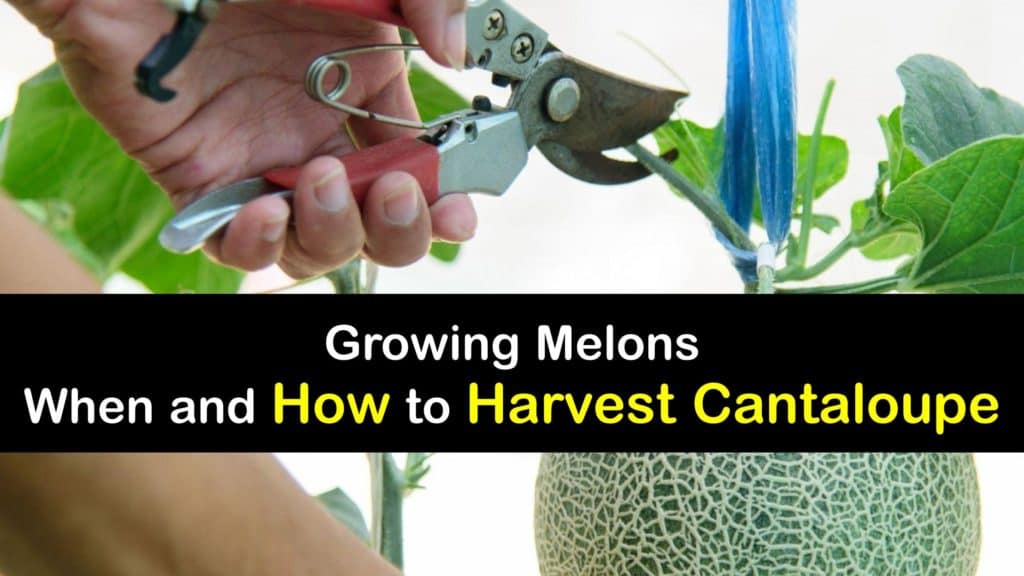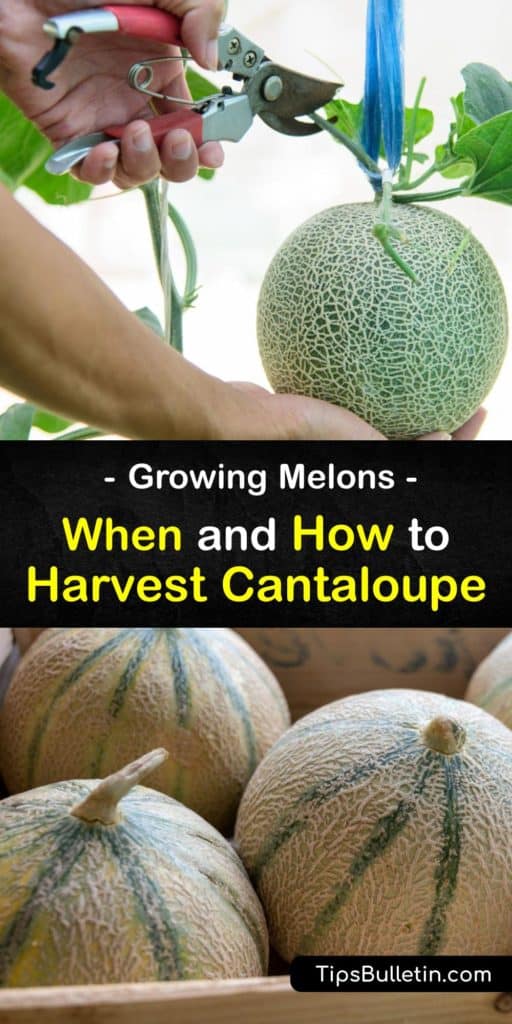You’ve learned how to grow cantaloupe and eagerly await harvest time, but how do you know when those sweet, round fruits are ready to begin picking? Learn when and how to harvest cantaloupe at the end of the growing season and use ripe melon in a tasty dish.
A lot goes into growing cantaloupe in the home garden. First, you plant the seeds and wait for germination, spread black plastic mulch and cover the young plants with row covers. Then, you install a drip irrigation system and position the trellis for air circulation.
As if that isn’t enough, cucumber beetles and other harmful pests cause damage and wilting, and fungal and bacterial diseases like powdery mildew and blossom end rot to control. After all your hard work, the final step is to know how and when to pick ripe cantaloupe for the best flavor.

The Best Ways to Harvest Cantaloupe
Like watermelon, muskmelon, and honeydew melons, cantaloupes have a long growing season, and it’s often difficult to know when to begin harvesting cantaloupe. There’s little difference between watermelon and canteloupe regarding the time to harvest. After you go through planting, using a homemade watermelon fertilizer or cantaloupe food, and picking bugs off your plants, you can’t wait for a tasty harvest.
Different cantaloupe cultivars range in size and appearance, and their growth rate varies. The difference between muskmelon and cantaloupe is negligible when growing them yourself.

However, a few signs indicate your cantaloupes are ready for picking. Find out when to harvest cantaloupe for the perfect ripeness and how to pick cantaloupe without damaging the fruit. Explore tips for storing ripe melon and how to use it in a recipe.
When to Harvest Cantaloupe
There are many types of cantaloupe, and they each have their own growth rate. After you sprout cantaloupe seeds, some are ready to pick in about 70 days, while others are not ripe until after 90 days. Learn when to harvest cantaloupe according to type.
Cantaloupe (Cucumis melo var. Cantalupensis) are cucurbits, and there are many varieties. Some of the different kinds of cantaloupe have bright orange flesh, and others are creamy yellow, and they range in flavor, from musky to extra sweet. All types have male and female flowers, and pollination is necessary to produce fruit.
How long does it take for cantaloupe to grow? It depends on the type of melon you plant. For example, the Aphrodite hybrid has honey-like flavored flesh and heavy netting and is mature in 72 days, while the Planters Jumbo melon has deep orange flesh with smooth netting, and it takes up to 90 days to mature.
The Zena melon has salmon-colored flesh with a sweet flavor, and it is a fast grower, reaching maturity in about 70 days. The Hearts of Gold cantaloupe produces three-pound fruits after 80 to 90 days.
Bush Star is an ideal variety for small gardens, and this type is ready to pick in 90 days, while the Minnesota Midget is suitable for growing in cold regions, producing one-pound fruits in 70 to 80 days.
How to Harvest Cantaloupe
When are cantaloupe ready to harvest? Cantaloupe harvest time varies, and it’s important to read the seed packet for your cultivar to get an accurate time frame, whether you are planting cantaloupe in containers, a raised bed, or the garden.
Once you have an idea of your plant’s growth rate, it’s time to begin harvesting. Here is how to harvest cantaloupe and ways to store the melons.
Similar to the typical watermelon picking guide, check your melons regularly as the harvest time draws near according to your type. Look at the rind and prepare to pick them when they change from green to tan or yellow. Another indication of ripeness is a crack in the stem where it attaches to the fruit.
Ripe fruit is easy to separate from the cantaloupe vines, while fruit that falls off by itself is usually overripe. To harvest the cantaloupe, pick up the melon with one hand and gently pull or prune the stem from the fruit with the other hand.
It’s safe to store uncut cantaloupe at room temperature for a few days if you keep it away from direct sunlight. Otherwise, store the whole melon in the crisper drawer of your refrigerator, where the humidity is higher. If you cut the melon in half, wrap the exposed area with plastic wrap and refrigerate it for no more than three days.
For more extended storage after harvesting cantaloupe, consider freezing the fruits. Slice, cube, or ball the melon and place the pieces in a single layer on a baking sheet.
Flash freeze them in the freezer for several hours or overnight and transfer the frozen melons to a freezer bag or airtight container. Return them to the freezer and use the pieces for adding to smoothies or summer soups.
Make a Refreshing Beverage after Harvesting Cantaloupe
Once you know when to pick cantaloupe and you begin harvesting the melons, you get to enjoy the benefit of eating all of the fruits. This drink is a fun and unique way to use fresh cantaloupe, and it’s refreshingly healthy.
After you harvest cantaloupes, cut up one large melon until you have five cups of cantaloupe, and place them in a blender. Add the agave and water and blend until smooth, working in batches if necessary.
Strain the juice to remove pulp for a smooth consistency, and pour the liquid into a large pitcher. Muddle some fresh mint and rosemary, add them to the juice, and serve chilled over ice.
There is nothing better than harvesting ripe melons from your own garden, whether you grow honeydew, watermelon, or cantaloupe. However, there is a big difference between picking them too early and picking them too late, and knowing the ideal time to harvest ensures that you get the perfect melons.

Knowing when and how to harvest cantaloupe is the key to picking the tastiest fruit, so why not share our cantaloupe harvesting guide with the melon-lovers in your life on Pinterest and Facebook?